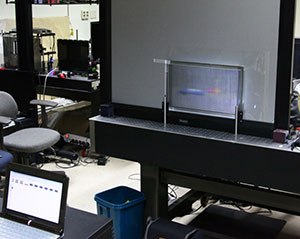
|
We've all seen those ads for LASIK that urge people to "throw their glasses away" after having the surgery.
Now a team of South Korean investigators are developing a glasses-free 3D viewing technology for commercial theaters that could let movie goers throw away their passive 3D glasses. According to a paper published recently in the Optical Society's open-access journal Optics Express, their new technique can bring this added dimension while using space more efficiently and at a lower cost than current 3D projection technology.
"There has been much progress in the last 10 years in improving the viewers' experience with 3D," noted the team's lead researcher Byoungho Lee, professor at the School of Electrical Engineering, Seoul National University in South Korea. "We want to take it to the next step with a method that, if validated by further research, might constitute a simple, compact, and cost-effective approach to producing widely available 3D cinema, while also eliminating the need for wearing polarizing glasses."
To create modern 3D effects, movie theaters use linearly or circularly polarized light. In this technique, two projectors display two similar images, which are slightly offset, simultaneously on a single screen. Each projector allows only one state of polarized light to pass through its lens. By donning the familiar polarized glasses, each eye perceives only one of the offset images, creating the depth cues that the brain interprets as three dimensions.
The two-projector method, however, is cumbersome, so optical engineers have developed various single projector methods to achieve similar effects. The parallax barrier method, for example, succeeds in creating the illusion of 3D, but it is cumbersome as well, as it requires a combination of rear projection video and physical barriers or optics between the screen and the viewer. Think of these obstructions as the slats in a venetian blind, which create a 3D effect by limiting the image each eye sees. The South Korean team has developed a new way to achieve the same glasses-free experience while using a single front projector against a screen.
In their system, the Venetian blinds' "slat" effect is achieved by using polarizers, which stop the passage of light after it reflects off the screen. To block the necessary portion of light, the researchers added a specialized coating to the screen known as a quarter-wave retarding film. This film changes the polarization state of light so it can no longer pass through the polarizers.
As the light passes back either through or between the polarizing slates, the offset effect is created, producing the depth cues that give a convincing 3D effect to the viewer, without the need for glasses.
The team's experimental results show the method can be used successfully in two types of 3D displays. The first is the parallax barrier method, described above, which uses a device placed in front of a screen enabling each eye to see slightly different, offset images. The other projection method is integral imaging, which uses a two-dimensional array of many small lenses or holes to create 3D effects.
"Our results confirm the feasibility of this approach, and we believe that this proposed method may be useful for developing the next generation of a glasses-free projection-type 3D display for commercial theaters," said Lee.
As a next step in their research, the team hopes to refine the method, and apply it to developing other single-projector, frontal methods of 3D display, using technologies such as passive polarization-activated lens arrays and the lenticular lens approach.
While their experimental results are promising, it may be several years until this technology can be effectively deployed in your local movie theater for you to enjoy without polarizing glasses.
The experimental setup of a proposed glasses-free 3D theater experience is shown above, with the projector in the familiar front position, creating 3D images. Photo courtesy of Optics Express.











